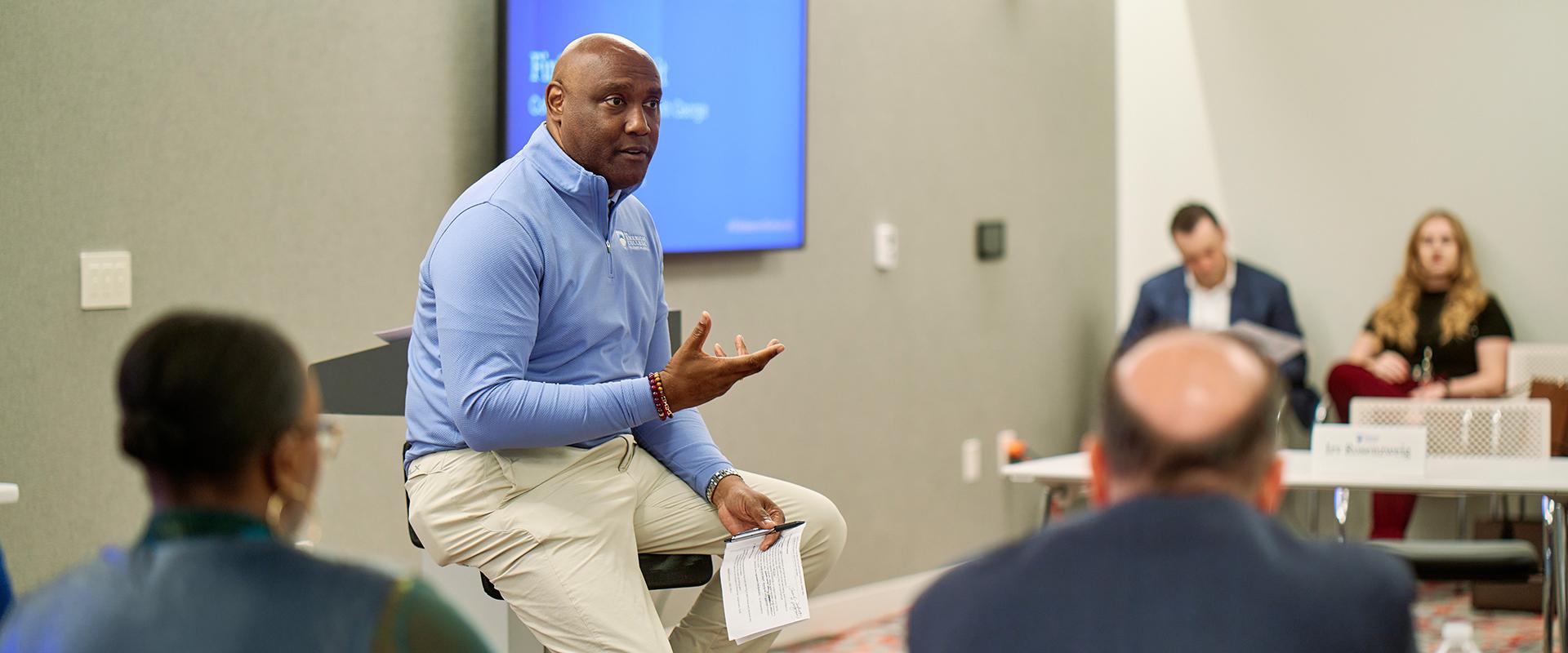Ambassadors Discuss Donor-Advised Funds and More at FinServe Summit
A panel on how financial professionals can grow their knowledge and businesses with philanthropic planning expertise.
Subscribe to Newsletter
Related Posts
College News Roundup: July - August 2025
View DetailsCollege to Host 11th Annual Military Summit
View Details2025 lang dixon award winner
View DetailsPhilanthropic Planning Insights
November 26, 2024
Ambassadors from The College’s FinServe Network sat down with College President and CEO George Nichols III, CAP® for a conversation on the growing importance of philanthropic planning at this year’s FinServe Network Summit.

Joining President Nichols for the panel discussion were FinServe Network ambassadors Rick Peck, CFP®, ChFC®, CAP®, an independent philanthropy consultant, and Mary Fischer-Nassib, CAP®, co-founder and CEO of the charitable organization Sow Good Now. Both ambassadors came prepared to dive deep into donor-advised funds (DAFs), one of the biggest trending topics in the philanthropic planning space today. A DAF is an account where an individual can deposit assets for donation to charity over time, recommending how to invest the assets or where to donate them and perhaps having a sponsor organization manage the account. DAF owners can also claim a tax deduction for making contributions to the fund each year.
While Nichols acknowledges there are many ways to give, including through checkbook giving or private foundations, he says he is amazed by how simple it is to set up a DAF today and how popular they are becoming. Peck credits these funds’ popularity with their ability to bypass complex giving schemes and make charity easy.
“DAFs used to have a $5,000 minimum threshold; now it’s $0, which makes them far more accessible,” he said. “People can give to others’ DAFs if they don’t want to create their own, costs are generally low, and there are many different investment or giving choices: you can set money aside in a DAF but delay the giving until you really want to do it.”
How to Use Donor-Advised Funds
While both Peck and Fischer-Nassib say they work with DAFs often in their businesses, the industry still needs to understand how to work with them more effectively.
“About 30% of the gifts we see today come from DAFs, but only 15% of nonprofits are set up to accept non-cash assets through DAFs; the problem is that non-cash assets are actually the majority of assets we see transferred,” Fischer-Nassib said. “We as an industry need to get educated, comfortable, and confident on how to use DAFs because they’re growing in popularity.”
Peck agrees with her assessment. “A lot of nonprofits are asking for cash only, even though most people aren’t in a position to give cash,” he said. “Instead, most people want to give other things: retirement plans and real estate; stocks, bonds, or mutual funds; cash value of life insurance; and personal property. Many nonprofits aren’t comfortable taking those because they’re not as easy to tabulate, but those gifts capture a lot of wealth that might not otherwise be going to charity.”
The ambassadors emphasize that there may be a steep learning curve for financial professionals who are unfamiliar with DAFs or charitable giving in general, but that the importance of understanding them justifies the investment of time. They say DAFs are a tool that can be used in many different professions and areas of financial planning and that they are one of the most effective, efficient, and powerful tools in a planner’s arsenal.
Regulating Donor-Advised Funds
President Nichols and the ambassadors also discussed the controversies surrounding DAFs, mainly consisting of unclear or inconsistent regulation and a public relations issue where some may see DAFs as hoarding vehicles: an avenue to avoid taxes by hiding away money but never using it to give. Peck, however, says this perception is unfounded.
“We actually see over 20% of DAF funds being distributed to communities and charities, with about $300 billion in all the DAFs out there,” he said. “In contrast, private foundations have $1.3 trillion all told, and yet they only distribute about 6% on average. There’s really no contest as to which is giving out more.”
However, the ambassadors did acknowledge the fiduciary uncertainty surrounding regulation of DAFs and how the financial services industry should approach using them. They say financial professionals have often been on the sidelines when it comes to managing DAFs and not intimately involved with the actual process of giving — something they hope will change given more education on the subject.
“If nonprofits are seeking funding and can’t get it through traditional sources, The College should get involved with educating people on how DAFs can be useful,” Fischer-Nassib said. “As a nonprofit leader, I’m looking for gifts given over several years, which DAFs are very useful for. They give you more muscle as a donor and more potential support from nonprofits as an advisor.”
In conclusion, our ambassadors say education is key to combating misconceptions about DAFs and other methods of philanthropic planning, as is recognizing the many different ways people can give — from their time and talent to treasure, testimony, and other methods. They say a more modern conception of giving is needed to encompass all the alternatives financial professionals have and the good they can do.
“Much of traditional philanthropy is top-down: people tell an underserved community what they’re going to do for them, or what they’re allowed to do with the money they’re given,” Fischer-Nassib said. “But if we really believe in those communities and want to give them resources but let them make their own decisions about what they need to thrive and succeed, DAFs are one of the best ways to make that happen.”
More From The College
- Meet Our FinServe Network
- Learn About Our Chartered Advisor in Philanthropy® (CAP®) Designation
Related Posts
College News Roundup: July - August 2025
View DetailsCollege to Host 11th Annual Military Summit
View Details2025 lang dixon award winner
View Details